- Vibrios are inhabitants of the marine environment and are aquatic bacteria that can be found as planktons.
- They are normally present in aquatic animals and seafood products and only a few Vibrio species are pathogenic to humans and cause illness.
- Vibrio species are categorized into two groups: Choleragenic which includes only one species Vibrio cholerae and non-choleragenic type namely, Vibrio parahaemolyticus, Vibrio vulnificus, Vibrio fluvialis, and Vibrio metschnikovii.
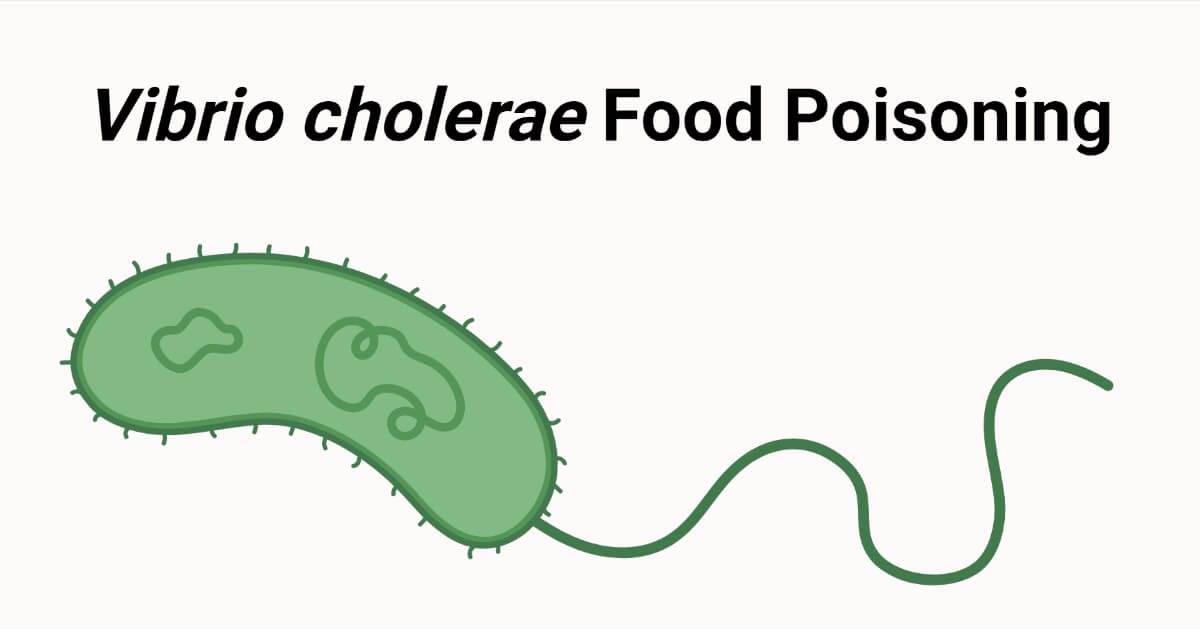
- When contaminated water or food is ingested, Vibrio cholera causes serious diarrheal illness resulting in watery diarrhea and severe dehydration.
- V. cholerae has two serotypes of toxigenic strains O1 and O139.
- Non-choleragenic bacteria cause mild and less serious illnesses and do not cause epidemics.
- Choleragenic bacteria also cause septicemia when a wound or cuts on the skin of a person comes in contact with contaminated water or sea products.
- The mortality rate of cholera is high as compared to other food-borne illnesses and often causes an outbreak in developing countries.
- Vibrio food poisoning is rare in high-income and developed countries which might be due to proper sanitation practices.
- Each year it is estimated that 91,000 death are reported due to cholera infection which is of high concern for the public health commission on controlling the disease.
Interesting Science Videos
Characteristics of Vibrio cholerae
- Gram-negative bacteria
- Curved-rod or comma-shaped
- Non-spore forming
- Aerobes or facultatively anaerobes
- Motile with a single polar flagellum
- Temperature range from 14 to 40°C
- Can survive NaCl concentration of 6%
- pH range 6.5 to 9
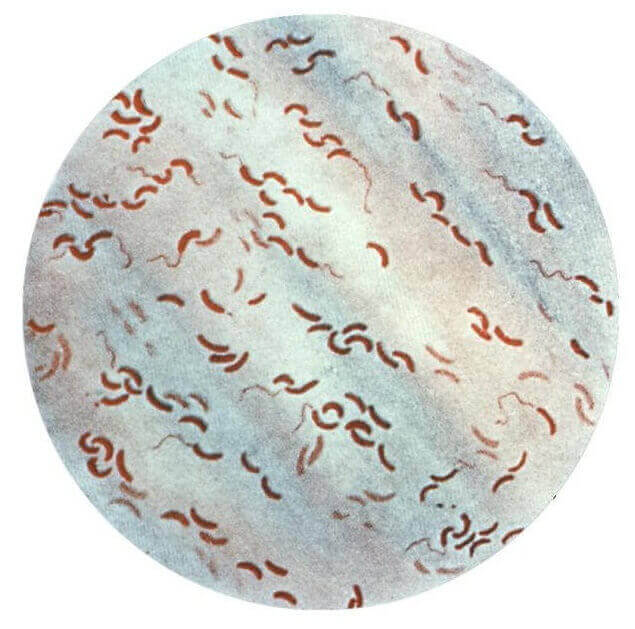
Sources of contamination of Vibrio cholerae Food Poisoning
- Fresh, brackish, and marine waters are the major reservoir of Vibrio and are found in aquatic animals, seabirds, sewage water, sediments, and inanimate surfaces.
- They also live within chitinous zooplankton, bivalve shellfish such as clams, oysters, and mussels.
- Cholera is transmitted from one person to another from water contaminated with feces and bacteria.
- Food poisoning is relatively high during the summer season as bacterial growth is favored during this month but cannot survive low temperatures (10°C).
- It is also present in water salinity of 5-30%.
Vibrio cholerae Food Poisoning Clinical Symptoms
- Cholera infection starts appearing after 12 hours to 15 days of consumption.
- The severity of illness depends on the biotypes strains of V. cholerae that have been ingested.
- Classical biotypes cause mild illness whereas biotype EI Tor strain caused pandemics recently.
- If the case is more severe, then the illness increases rapidly during the 24 hours of infection.
- Rice watery diarrhea with fishy odor, pale grey stool with severe abdominal cramp, and high fever are the symptoms of cholera gravis.
- If the patient fails to receive medical treatment, the illness leads to severe dehydration, loss of electrolytes, circulatory collapse, and death.
- Dehydrated patients appear to have sunken eyes, dry and dull skin, low urine volume, low pulse rate, low body weight, and are not able to eat and drink.
- Cholera patients may suffer from be hypoglycemiac i.e, low blood glucose level.
- Prolonged hypotension may lead to acute renal failure.
Vibrio cholerae Food Poisoning Epidemiology
- V. cholerae caused the first outbreak in Indian subcontinents and was considered a cholera endemic zone.
- This disease is still reemerging in several parts of the globe mainly in low-income, developing, and under-developed countries.
- Developed countries are less affected and are seen sporadically.
- Recently, 69 countries and 1.3 billion people are at risk of cholera infection inand countries like Africa, Asia, and South America.
- During 2019, 923,037 cases, 1911 deaths from 31 countries were notified to WHO (Cholera Annual Report 2019).
- Sub-saharan Africa is highly affected by the cholera outbreak which is due to a lack of safe drinking water and poor sanitation.
- Haiti was not affected by cholera until 2010, but an outbreak occurred in a total of 534,647 cases, 287,656 hospitalized, and 7091 death.
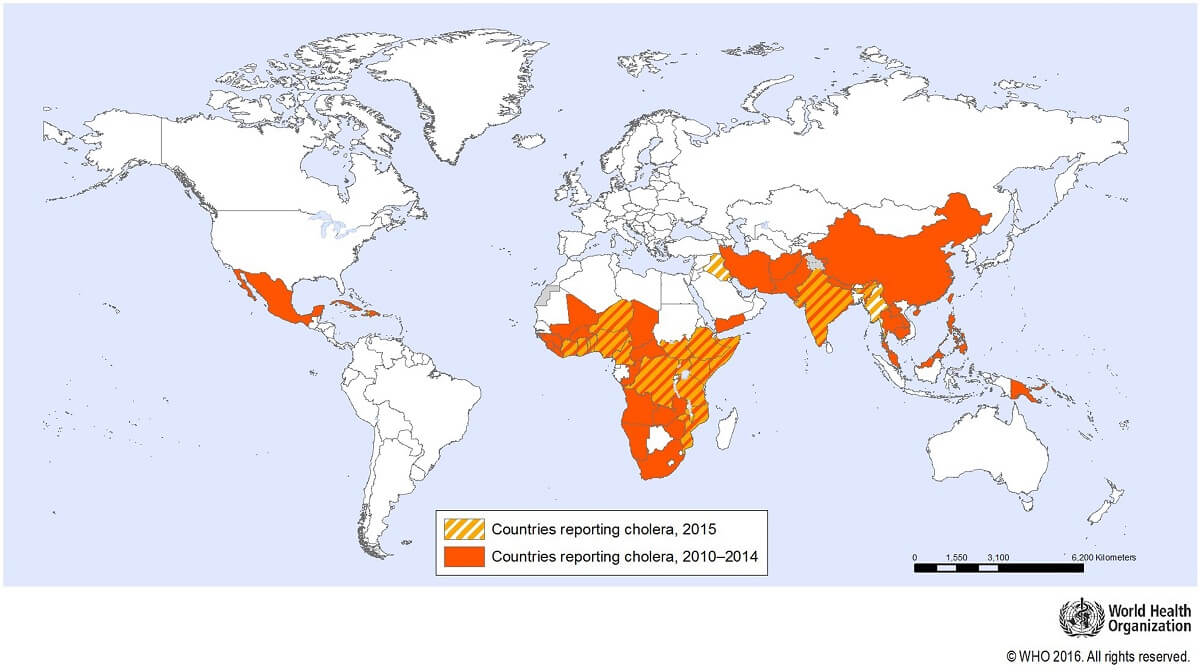
- V. cholerae O1 EI Tor strain was responsible for the occurrence of an outbreak not only in Haiti but in Angola in 2006.
- Europe and North America have limited illness of cholera due to their advanced sanitation systems and availability of safe drinking water.
- Outbreak occurs when there is a natural disaster like earthquake and flood, war and conflicts between two nations, movement of the refugee from one country to another.
- The mortality rate is high for all age groups especially young children who are seriously affected by this disease.
Vibrio cholerae Food Poisoning Pathogenesis
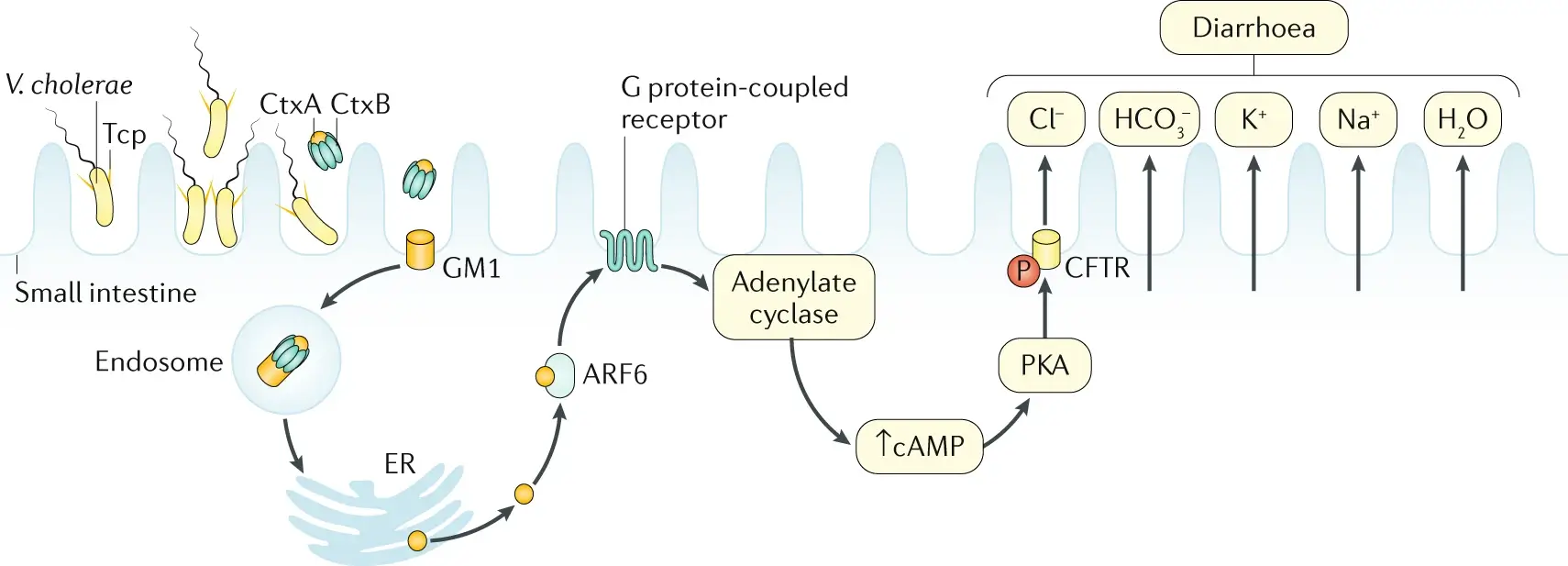
- The pathogenicity of V. cholerae is mediated by the virulence factors CT and TCP which are long filamentous pili that help in the attachment and colonization of bacterial cells in the human intestine.
- The tcpA gene of the Vibrio pathogenicity island (VPI) – I act as a receptor that adheres to the host cell.
- Cholera toxin (CT) is the most important virulence factor that targets the cell by producing a protein called adenosine diphosphate (ADP)-ribosylation of guanosine triphosphate (GTP)- binding protein.
- This protein locks the adenylate cyclase enzyme and changes its conformation resulting in increased activation of the enzyme.
- This leads to the decrease of intracellular cAMP level that disrupts the epithelial cell membrane and causes massive fluid loss and watery diarrhea.
- Cholera is mediated by non-invasive enterotoxin CT produced by the strains of V. cholerae O1 and O139.
- These strains cause sporadic cases that cause invasive extraintestinal illness like fatal bacteremia and are different from CT illness.
Vibrio cholerae Detection methods
- Isolation of organism from stool sample with the use of selective media such as thiosulfate-citrate-bile salt-sucrose (TCBS) agar, cellobiose polymyxin B colistin (CPC), and mannitol-maltose agar.
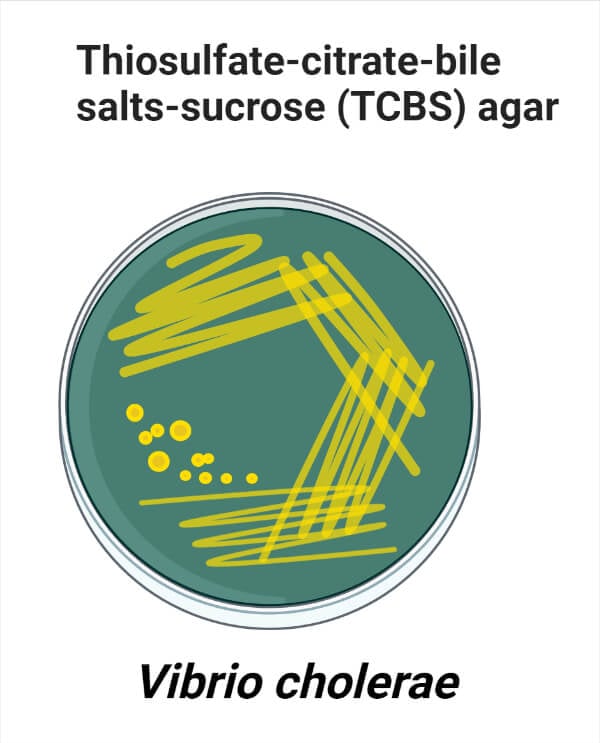
- The organism can be confirmed by the ‘shooting star’ movement in cholera stool when observed under a dark field microscope.
- The dipstick ELISA method also detects and differentiates the toxigenic and non-toxigenic V. cholerae with high sensitivity and specificity.
- PCR-based assays are also helpful in detecting the virulence recA genes of the pathogen.
- This method uses unique oligonucleotide primers and gives fast and specific results.
Vibrio cholerae Food Poisoning Treatment
- Treatment includes fluid therapy and bed rest with oral or intravenous rehydration.
- Oral rehydration solutes are commercially available in the markets.
- Antibiotics such as tetracycline, cotrimoxazole, doxycycline, erythromycin, chloramphenicol, and furazolidone are used as a single oral dose to reduce the infection period.
- But resistance to tetracycline and azithromycin has been reported recently.
- A live oral vaccine with killed bacterial genes has shown to be effective about 80% in adults.
Vibrio cholerae Food Poisoning Prevention and Control measures
- Cholera control can be done by maintaining good sanitation around the surroundings, provision safe potable drinking water.
- Boiling water, cooking food thoroughly at an adequate temperature, proper storage of cooked foods, and reheating before consumption.
- Improve handling, processing, and packaging of raw seafood products to prevent bacterial contamination.
- The use of citrus juice like lemon and oranges reduces bacterial growth as it cannot survive in low acidic pH.
- Avoid seafood products if a person has liver disease, diabetes, and kidney disease which might be fatal.
- Educating the public with clean water consumption, proper use of vaccination, and antibiotics to eliminate the chance of cholera infection.
References
- Morris, J. G. (2017). Cholera and Other Vibrioses. International Encyclopedia of Public Health, 1–8.
- Mandal, S., & Mandal, M. (2014). VIBRIO | Vibrio cholerae. Encyclopedia of Food Microbiology, 708–716.
- Jones, J. L. (2014). VIBRIO | Introduction, Including Vibrio parahaemolyticus, Vibrio vulnificus, and Other Vibrio Species. Encyclopedia of Food Microbiology, 691–698.
- Venkateswaran, K. (1999). VIBRIO | Standard Cultural Methods and Molecular Detection Techniques in Foods. Encyclopedia of Food Microbiology, 2248–2258.
- Meltzer, E., & Schwartz, E. (2007). Cholera: A Travel History of the First Modern Pandemic. Travel Medicine, 287–298.
- Baker-Austin, C., Oliver, J.D., Alam, M. et al. Vibrio spp. infections. Nat Rev Dis Primers 4, 1–19 (2018). https://doi.org/10.1038/s41572-018-0005-8.
- Finkelstein RA. Cholera, Vibrio cholerae O1 and O139, and Other Pathogenic Vibrios. In: Baron S, editor. Medical Microbiology. 4th edition. Galveston (TX): University of Texas Medical Branch at Galveston; 1996. Chapter 24. Available from: https://www.ncbi.nlm.nih.gov/books/NBK8407/
- Ojeda Rodriguez JA, Kahwaji CI. Vibrio Cholerae. [Updated 2021 Jun 4]. In: StatPearls [Internet]. Treasure Island (FL): StatPearls Publishing; 2022 Jan-. Available from: https://www.ncbi.nlm.nih.gov/books/NBK526099/
